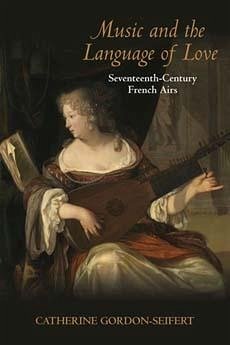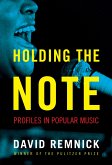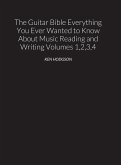- Gebundenes Buch
- Merkliste
- Auf die Merkliste
- Bewerten Bewerten
- Teilen
- Produkt teilen
- Produkterinnerung
- Produkterinnerung
She shows how airs deployed in both text and music an encoded language that was in sensuous contrast to polite society's cultivation of chaste love, strict gender roles, and restrained discourse.
Andere Kunden interessierten sich auch für
![Holding the Note Holding the Note]() David RemnickHolding the Note25,99 €
David RemnickHolding the Note25,99 €![Focus: Music in Contemporary Japan Focus: Music in Contemporary Japan]() Jennifer MatsueFocus: Music in Contemporary Japan203,99 €
Jennifer MatsueFocus: Music in Contemporary Japan203,99 €![Now That the Audience Is Assembled Now That the Audience Is Assembled]() David GrubbsNow That the Audience Is Assembled106,99 €
David GrubbsNow That the Audience Is Assembled106,99 €![Music in the Baroque World Music in the Baroque World]() Susan Lewis HammondMusic in the Baroque World249,99 €
Susan Lewis HammondMusic in the Baroque World249,99 €![Larissa, The Mistress of Large Music Larissa, The Mistress of Large Music]() Charles Roland BerryLarissa, The Mistress of Large Music38,99 €
Charles Roland BerryLarissa, The Mistress of Large Music38,99 €![50 Movie Music Moments 50 Movie Music Moments]() Vasco Hexel50 Movie Music Moments178,99 €
Vasco Hexel50 Movie Music Moments178,99 €![THE GUITAR BIBLE Everything You Ever Wanted to Know About Music Reading and Writing Volumes 1, 2, 3 and 4 THE GUITAR BIBLE Everything You Ever Wanted to Know About Music Reading and Writing Volumes 1, 2, 3 and 4]() Ken HodgsonTHE GUITAR BIBLE Everything You Ever Wanted to Know About Music Reading and Writing Volumes 1, 2, 3 and 4127,99 €
Ken HodgsonTHE GUITAR BIBLE Everything You Ever Wanted to Know About Music Reading and Writing Volumes 1, 2, 3 and 4127,99 €-
-
-
She shows how airs deployed in both text and music an encoded language that was in sensuous contrast to polite society's cultivation of chaste love, strict gender roles, and restrained discourse.
Hinweis: Dieser Artikel kann nur an eine deutsche Lieferadresse ausgeliefert werden.
Hinweis: Dieser Artikel kann nur an eine deutsche Lieferadresse ausgeliefert werden.
Produktdetails
- Produktdetails
- Verlag: Indiana University Press
- Seitenzahl: 408
- Erscheinungstermin: 7. April 2011
- Englisch
- Abmessung: 239mm x 157mm x 33mm
- Gewicht: 676g
- ISBN-13: 9780253354617
- ISBN-10: 0253354617
- Artikelnr.: 28522714
- Herstellerkennzeichnung
- Libri GmbH
- Europaallee 1
- 36244 Bad Hersfeld
- 06621 890
- Verlag: Indiana University Press
- Seitenzahl: 408
- Erscheinungstermin: 7. April 2011
- Englisch
- Abmessung: 239mm x 157mm x 33mm
- Gewicht: 676g
- ISBN-13: 9780253354617
- ISBN-10: 0253354617
- Artikelnr.: 28522714
- Herstellerkennzeichnung
- Libri GmbH
- Europaallee 1
- 36244 Bad Hersfeld
- 06621 890
Catherine Gordon-Seifert
Acknowledgments
Note on Quotations, Translations, and Musical Examples
Introduction
1. Music and Texts: An Overview of the Sources
A General Description of the Air
The Publications
The Composers
Publications by Lambert, Bacilly, La Barre, and Le Camus: A Description
The Song Texts
Poetic Structure
Style or Elocution: Figurative Language and Poetic Syntax
Poetry and Rhetoric
2. Rhetoric and Meaning in the Seventeenth-Century French Air
Seventeenth-Century French Sources on Rhetoric and Music
Persuading the Passions
3. Musical Representations of the Primary Passions
The Primary Passions
The Agitated Passions
The Modest Passions
The Neutral Passion
Summary
4. Setting the Texts
Painful Love
Bittersweet Love
Enticing Love
Joyous Love
Summary
5. Form and Style: The Organization and Function of Expressions, Syntax,
and Rhetorical Figures
Form (Disposition)
The Organization of Expressions in Short Airs
The Organization of Expressions in Long Airs
Form in Single-Strophe Airs
The Rhetorical Sections of a Piece: Their Function and Expression
Style (Elocution): Poetic Structure, Punctuation, and Rhetorical Figures
6. L'Art du Chant: Performing French Airs
À Haute Voix
The Art of Proper Singing
Ornamentation
The Pronunciation of Seventeenth-Century French
Syllabic Quantity
Tempo
Le Mouvement
Repeats
Basso Continuo Accompaniment
7. Salon Culture and the Mid-Seventeenth-Century French Air
The French Air and Conversation
Musical Seductions
Galanterie and the Air: Undercurrents of Eroticism and Lessons of Morality
Women Singing Airs as Men
8. The Late-Seventeenth-Century Air and the Rhetoric of Distraction
The Air after 1670
Songs and the Rhetoric of Distraction
Pleasure, Airs, and the New Rhetoric
The Legacy of Lambert, Bacilly, Le Camus, and La Barre
Notes
Bibliography
Index
Note on Quotations, Translations, and Musical Examples
Introduction
1. Music and Texts: An Overview of the Sources
A General Description of the Air
The Publications
The Composers
Publications by Lambert, Bacilly, La Barre, and Le Camus: A Description
The Song Texts
Poetic Structure
Style or Elocution: Figurative Language and Poetic Syntax
Poetry and Rhetoric
2. Rhetoric and Meaning in the Seventeenth-Century French Air
Seventeenth-Century French Sources on Rhetoric and Music
Persuading the Passions
3. Musical Representations of the Primary Passions
The Primary Passions
The Agitated Passions
The Modest Passions
The Neutral Passion
Summary
4. Setting the Texts
Painful Love
Bittersweet Love
Enticing Love
Joyous Love
Summary
5. Form and Style: The Organization and Function of Expressions, Syntax,
and Rhetorical Figures
Form (Disposition)
The Organization of Expressions in Short Airs
The Organization of Expressions in Long Airs
Form in Single-Strophe Airs
The Rhetorical Sections of a Piece: Their Function and Expression
Style (Elocution): Poetic Structure, Punctuation, and Rhetorical Figures
6. L'Art du Chant: Performing French Airs
À Haute Voix
The Art of Proper Singing
Ornamentation
The Pronunciation of Seventeenth-Century French
Syllabic Quantity
Tempo
Le Mouvement
Repeats
Basso Continuo Accompaniment
7. Salon Culture and the Mid-Seventeenth-Century French Air
The French Air and Conversation
Musical Seductions
Galanterie and the Air: Undercurrents of Eroticism and Lessons of Morality
Women Singing Airs as Men
8. The Late-Seventeenth-Century Air and the Rhetoric of Distraction
The Air after 1670
Songs and the Rhetoric of Distraction
Pleasure, Airs, and the New Rhetoric
The Legacy of Lambert, Bacilly, Le Camus, and La Barre
Notes
Bibliography
Index
Acknowledgments
Note on Quotations, Translations, and Musical Examples
Introduction
1. Music and Texts: An Overview of the Sources
A General Description of the Air
The Publications
The Composers
Publications by Lambert, Bacilly, La Barre, and Le Camus: A Description
The Song Texts
Poetic Structure
Style or Elocution: Figurative Language and Poetic Syntax
Poetry and Rhetoric
2. Rhetoric and Meaning in the Seventeenth-Century French Air
Seventeenth-Century French Sources on Rhetoric and Music
Persuading the Passions
3. Musical Representations of the Primary Passions
The Primary Passions
The Agitated Passions
The Modest Passions
The Neutral Passion
Summary
4. Setting the Texts
Painful Love
Bittersweet Love
Enticing Love
Joyous Love
Summary
5. Form and Style: The Organization and Function of Expressions, Syntax,
and Rhetorical Figures
Form (Disposition)
The Organization of Expressions in Short Airs
The Organization of Expressions in Long Airs
Form in Single-Strophe Airs
The Rhetorical Sections of a Piece: Their Function and Expression
Style (Elocution): Poetic Structure, Punctuation, and Rhetorical Figures
6. L'Art du Chant: Performing French Airs
À Haute Voix
The Art of Proper Singing
Ornamentation
The Pronunciation of Seventeenth-Century French
Syllabic Quantity
Tempo
Le Mouvement
Repeats
Basso Continuo Accompaniment
7. Salon Culture and the Mid-Seventeenth-Century French Air
The French Air and Conversation
Musical Seductions
Galanterie and the Air: Undercurrents of Eroticism and Lessons of Morality
Women Singing Airs as Men
8. The Late-Seventeenth-Century Air and the Rhetoric of Distraction
The Air after 1670
Songs and the Rhetoric of Distraction
Pleasure, Airs, and the New Rhetoric
The Legacy of Lambert, Bacilly, Le Camus, and La Barre
Notes
Bibliography
Index
Note on Quotations, Translations, and Musical Examples
Introduction
1. Music and Texts: An Overview of the Sources
A General Description of the Air
The Publications
The Composers
Publications by Lambert, Bacilly, La Barre, and Le Camus: A Description
The Song Texts
Poetic Structure
Style or Elocution: Figurative Language and Poetic Syntax
Poetry and Rhetoric
2. Rhetoric and Meaning in the Seventeenth-Century French Air
Seventeenth-Century French Sources on Rhetoric and Music
Persuading the Passions
3. Musical Representations of the Primary Passions
The Primary Passions
The Agitated Passions
The Modest Passions
The Neutral Passion
Summary
4. Setting the Texts
Painful Love
Bittersweet Love
Enticing Love
Joyous Love
Summary
5. Form and Style: The Organization and Function of Expressions, Syntax,
and Rhetorical Figures
Form (Disposition)
The Organization of Expressions in Short Airs
The Organization of Expressions in Long Airs
Form in Single-Strophe Airs
The Rhetorical Sections of a Piece: Their Function and Expression
Style (Elocution): Poetic Structure, Punctuation, and Rhetorical Figures
6. L'Art du Chant: Performing French Airs
À Haute Voix
The Art of Proper Singing
Ornamentation
The Pronunciation of Seventeenth-Century French
Syllabic Quantity
Tempo
Le Mouvement
Repeats
Basso Continuo Accompaniment
7. Salon Culture and the Mid-Seventeenth-Century French Air
The French Air and Conversation
Musical Seductions
Galanterie and the Air: Undercurrents of Eroticism and Lessons of Morality
Women Singing Airs as Men
8. The Late-Seventeenth-Century Air and the Rhetoric of Distraction
The Air after 1670
Songs and the Rhetoric of Distraction
Pleasure, Airs, and the New Rhetoric
The Legacy of Lambert, Bacilly, Le Camus, and La Barre
Notes
Bibliography
Index








